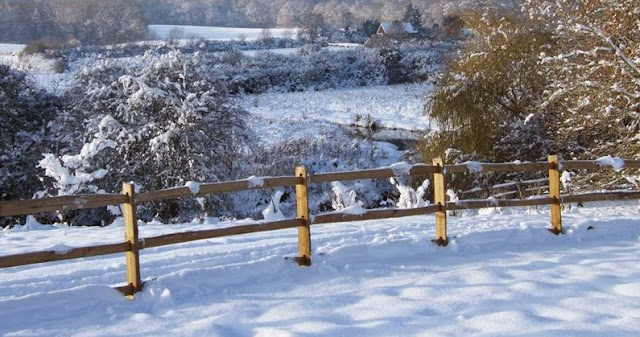Fences and Snow. Its snow joke if your fence collapses.
Reports from long range weather forecasters warning us that Britain should prepare for heavy and
persistent snow and the worst winter for more than 60 years is enough to make anyone shiver! But with predictions of above average snowfall and plunging temperatures, it makes sense to act now to ensure your fencing and gates are up to the challenge of coping with such extreme conditions.
Although pretty enough depicting a Christmas scene, fences and gates topped with snowfall are far from festive if the end result is rotting timber and dropped gates!
It’s not just fencing that is likely to be affected by adverse weather – keeping a vehicle outside during the colder months is far from ideal but the new Timber Car Port will protect your car from the elements – and you’ll never have to waste precious time scraping the ice off your windows again.
 |
| Post & Rail in the Snow |
The Impact of Snow and Ice on Fences
Snowfall may appear light and fluffy at first, but as it accumulates, its weight increases significantly. A cubic foot of snow can weigh anywhere from 10 to 20 pounds, depending on its moisture content, and wet, compacted snow is even heavier. When this weight is distributed along a fence, particularly one not designed to handle such loads, the structure can buckle or collapse.
In addition to snow, ice build-up poses another challenge. Freezing rain and fluctuating temperatures can lead to ice formation, adding extra weight to fences. Ice often clings to every surface, including posts, rails, and panels, amplifying stress on the structure. This combination of snow and ice can push even a moderately built fence to its breaking point.
Why a Strong Fence Matters
Structural Integrity: A well-constructed fence ensures that it can withstand heavy snow loads without bowing, breaking, or collapsing. This is particularly important in areas prone to blizzards or consistent snowfall throughout the winter.
Safety: A weak or damaged fence can pose safety hazards. Collapsing sections may injure people or animals, or damage surrounding property.
Privacy and Security: In snowy regions, a fence serves as a barrier against wildlife seeking shelter or food on your property. A compromised fence can lead to unwanted intrusions.
Snow Drifts: Strong fences can also help control snow drifts by acting as a windbreak, preventing snow from piling up in certain areas of your property.
Longevity: Investing in a strong fence designed to withstand harsh winters reduces the need for frequent repairs or replacements, saving time and money in the long run.
Key Features of a Winter-Ready Fence
Durable Materials: look for materials like treated wood or metal that can resist moisture and freezing temperatures. Avoid untreated wood, as it can rot or warp when exposed to snow and ice. Look for long guarantees on fences, like 25 years.
Reinforced Posts: Fence posts should be deeply anchored into the ground, ideally below the frost line, to prevent shifting or leaning caused by frost heave. In addition a well treated fence that has long guarantees again.
Proper Spacing: Ensure panels and boards are evenly spaced to allow wind and light snow to pass through, reducing the accumulation of heavy drifts.
Sloped Design: Consider a design that sheds snow and ice easily, such as slanted or curved panels. In addition to this, components of a fence. An example is a Jacksons Featherboard Fence rail.
Regular Maintenance: Check for weak points, loose fastenings, or signs of rot before the snow season begins. Applying weatherproof coatings can also help extend the fence’s lifespan.
The importance of well constructed fences in areas prone to snow
A strong fence is more than just a boundary marker; in snowy areas, it becomes an essential part of winter preparedness. By choosing durable materials, reinforcing structures, and performing regular maintenance, you can ensure your fence stands strong against the weight of snow and ice. Not only does this protect your property and enhance safety, but it also provides peace of mind throughout the winter months.
Whether you're building a new fence or upgrading an existing one, investing in strength and resilience will pay dividends when the next snowstorm rolls in.
Updated in November 2024



